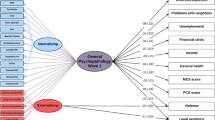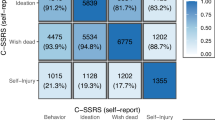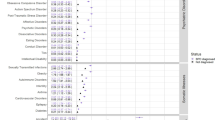Abstract
Separate inheritance of mania and depression together with high rates of clinical overlap of mania with anxiety and substance use disorders provide a basis for re-examining the specificity of the prospective association of manic and depression episodes that is a hallmark of bipolar disorder. We analyzed information from 34 653 adults in Waves 1 and 2 of the National Epidemiologic Survey on Alcohol and Related Conditions, a longitudinal nationally representative survey of US adults interviewed 3 years apart. Psychiatric disorders were assessed by a structured interview. We used logistic regression analyses to estimate the strength of associations between Wave 1 manic episodes and Wave 2 depression, anxiety and substance use disorders controlling for background characteristics and lifetime Wave 1 disorders. Corresponding analyses examined associations between Wave 1 major depressive episode with manic episodes and other psychiatric disorders. In multivariable models, Wave 1 manic episodes significantly increased the odds of Wave 2 major depressive episodes (adjusted odds ratio (AOR): 1.7; 95% confidence interval: 1.3–2.2) and any anxiety disorder (AOR: 1.8; 1.4-2.2), although not of substance use disorders (AOR: 1.2; 0.9–1.5). Conversely, Wave 1 major depressive episodes significantly increased risk of Wave 2 manic episodes (AOR: 2.2; 1.7–2.9) and anxiety disorders (AOR: 1.7; 1.5–2.0), although not substance use disorders (AOR: 1.0; 0.9–1.2). Adults with manic episodes have an approximately equivalent relative risk of developing depression episodes and anxiety disorders. Greater research and clinical focus is warranted on connections between manic episodes and anxiety disorders.
This is a preview of subscription content, access via your institution
Access options
Subscribe to this journal
Receive 12 print issues and online access
$259.00 per year
only $21.58 per issue
Buy this article
- Purchase on Springer Link
- Instant access to full article PDF
Prices may be subject to local taxes which are calculated during checkout
Similar content being viewed by others
References
Frye MA . Bipolar disorder—a focus on depression. N Engl J Med 2011; 364: 51–91.
Baek JH, Eisner LR, Nierenberg AA . Epidemiology and course of unipolar mania: results from the National Epidemiologic Survey on Alcohol and Related Conditions (NESARC). Depress Anxiety 2014; 31: 746–755.
Judd LL, Akiskal HS, Schettler PJ, Endicott J, Maser J, Soloman DA et al. The long-term natural history of the weekly symptomatic status of bipolar I disorder. Arch Gen Psychiatry 2002; 59: 540–537.
Johnson SL, Morriss R, Scott J, Paykel E, Kinderman P, Kolamunnage-Dona R et al. Depressive and manic symptoms are not opposite poles in bipolar disorder. Act Psychiatr Scan 2011; 123: 206–2011.
Merikangas KR, Cui L, Kattan G, Carlson G, Youngstrom EA, Angst J . Mania with and without depression in a community sample of U.S. adolescents. Arch Gen Psychiatry 2012; 69: 943–951.
Solomon DA, Leon AC, Endicott J, Coryell WH, Mueller TI, Posternak MA et al. Unipolar mania over the course of a 20-year follow-up study. Am J Psychiatry 2003; 160: 2039–2051.
Merikangas KR, Lihong C, Heaton L, Nakamura E, Roca C, Ding J et al. Independence of familial transmission of mania and depression: results of the NIMH family study of affective spectrum disorders. Mol Psychiatry 2014; 19: 214–219.
Vandeleur CL, Merikangas KR, Strippoli M-PF, Castelao E, Preisig M . Specificity of psychosis, mania and major depression in a contemporary family study. Mol Psychiatry 2014; 19: 209–213.
Kessler RC, Rubinow DR, Holmes C, Abelson JM, Zhao S . The epidemiology of DSM-III-R bipolar I disorder in a general population survey. Psychol Med 1997; 27: 1079–1089.
Cross-Disorder Group of the Psychiatric Genomics Consortium. Genetic relationships between five psychiatric disorders estimated from genome-wide SNPs. Nat Genet 2013; 45: 984–994.
Simon NM, Otto MW, Wisniewski SR, Fossey M, Sadduyu K, Frank E et al. Anxiety disorder comorbidity in bipolar disorder patients: data from the first 500 participants in the systematic treatment enhancement program for bipolar disorder (STEP-BD). Am J Psychiatry 2004; 161: 2222–2229.
Merikangas KR, Akiskal HS, Angst J, Greenberg PE, Hirschfeld RMA, Petukhova M et al. Lifetime and 12-month prevalence of bipolar spectrum disorder in the National Comorbidity Survey replication. Arch Gen Psychiatry 2007; 64: 543–352.
Perlis RH, Miyahara S, Marangell LB, Wisniewski SRM, Ostacher M, Delbello MP et al. Long-term implications of early onset in bipolar disorder: data from the first 1000 participants in the systematic treatment enhancement program for bipolar disorder (STEP-BD). Biol Psychiatry 2004; 55: 875–881.
Grant BF, Stinson FS, Hasin DS, Dawson DA, Chou SP, Ruan WJ et al. Prevalence, correlates, and comorbidity of bipolar I disorder and axis I and II disorders: results from the National Epidemiologic Survey on Alcohol and Related Conditions. J Clin Psychiatry 2005; 66: 1205–1215.
Frye MA, Altshuler LL, McElroy SL, Suppes T, Keck PE, Denicoff K et al. Gender differences in prevalence, risk, and clinical correlates of alcoholism comorbidity in bipolar disorder. Am J Psychiatry 2003; 160: 883–889.
Merikangas KR, Herrell R, Swendsen J, Rossler W, Ajdacic-Gross V, Angst J . Specificity of bipolar spectrum conditions in the comorbidity of mood and substance use disorders. Arch Gen Psychiatry 2008; 65: 47–52.
Kendler KS . Major depression and generalised anxiety disorder. Same genes, (partly) different environments—revisited. Br J Psychiatry 1996; 168: 68–75.
Kendler KS, Gardner CO, Gatz M, Pederson NL . The sources of co-morbidity between major depression and generalized anxiety disorder in a Swedish national twin sample. Psychol Med 2007; 37: 453–462.
Ware J, Kosinski M, Turner-Bowker D, Gandek B . SF-12v2: How to Score Version 2 of the SF-12 Health Survey. Quality Metric Incorporated: Lincoln, RI, USA, 2002, pp 29–38.
Grant BF, Harford TC, Dawson DA, Chou PS, Pickering RP . The Alcohol Use Disorder and Associated Disabilities Interview Schedule (AUDADIS): reliability of alcohol and drug modules in a general population sample. Drug Alcohol Depend 1995; 39: 37–44.
Ruan WJ, Goldstein RB, Chou SP, Smith SM, Saha TD, Pickering RP et al. The Alcohol Use Disorder and Associated Disabilities Interview Schedule-IV (AUDADIS-IV): reliability of new psychiatric diagnostic modules and risk factors in a general population sample. Drug Alcohol Depend 2008; 92: 27–36.
Grant BF, Dawson DA, Stinson FS, Chou SP, Kay W, Pickering RP . The Alcohol Use Disorder and Associated Disabilities Interview Schedule-IV (AUDADIS-IV): reliability of alcohol consumption, tobacco use, family history of depression and psychiatric diagnostic modules in a general population sample. Drug Alcohol Depend 2003; 71: 7–16.
Hanley JA, Negassa A, Forrester JE . Statistical analysis of correlated data using generalized estimating equations: an orientation. Am J Epidemiol 2003; 157: 364–375.
Parker G, Brotchie H . Gender differences in depression. Int Rev Psychiatry 2010; 22: 429–436.
Diflorio A, Jones I . Is sex important? Gender differences in bipolar disorder. Int Rev Psychiatry 2010; 22: 437–452.
Coryell W, Solomon DA, Fiedorowicz JG, Endicott J, Schettler P, Judd L . Anxiety and outcome in bipolar disorder. Am J Psychiatry 2009; 166: 1238–1243.
Kendler KS, Walters EE, Neale MC, Kessler RC, Heath AC, Eaves LJ . The structure of the generic and environmental risk factors for six major psychiatric disorders in women: phobia, generalized anxiety disorder, panic disorder, bulimia, major depression, and alcoholism. Arch Gen Psychiatry 1995; 52: 374–383.
Blanco C, Wall MM, He JP, Krueger RF, Olfson M, Jin CJ et al. The space of common psychiatric disorders in adolescents: comorbidity structure and individual latent liabilities. J Am Acad Child Adolesc Psychiatry 2015; 54: 45–52.
Blanco CA, Kreuger RF, Hasin DS, Liu SM, Wang S, Kerridge BT et al. Mapping common psychiatric disorders: structure and predictive validity in the National epidemiologic Survey on Alcohol and Related Conditions. JAMA Psychiatry 2013; 70: 199–208.
Hettema JM . The nosologic relationship between generalized anxiety disorder and major depression. Depress Anxiety 2008; 25: 300–316.
Hasin DS, Goodwin RD, Stinson FS, Grant BF . Epidemiology of major depressive disorder: results from the national epidemiologic survey on alcoholism and related disorders. Arch Gen Psychiatry 2005; 62: 1097–1106.
Blanco C, Rubio JM, Wall M, Wang S, Jiu CJ, Kendler KS . Risk factors for anxiety disorders: common and specific effects in a national sample. Depress Anxiety 2014; 31: 756–764.
Blanco C, Rubio JM, Wall M, Secades-Villa R, Beesdo-Baum K, Wang S . The latent structure and comorbidity patterns of generalized anxiety disorder and major depressive disorder: a national study. Depress Anxiety 2014; 31: 214–222.
Belzer K, Schneier FR . Comorbidity of anxiety and depressive disorders: issues in conceptualization, assessment, and treatment. J Psychiatr Pract 2004; 10: 296–306.
Sheehan DV, Harnet-Sheehan K, Hidalgo RB, Janavs J, McElroy SL, Amado D et al. Randomized, placebo-controlled trial of quetiapine-XR and divalproex-ER monotherapies in the treatment of the anxious bipolar patient. J Affect Disord 2013; 145: 83–94.
Perugi G, Frare F, Toni C, Tusini G, Vannucchi G, Akiskal HS . Adjunctive valproate in panic disorder patients with comorbid bipolar disorder or otherwise resistant to standard antidepressants: 3-year ‘open’ follow-up study. Eur Arch Psychiatry Clin Neurosci 2010; 260: 553–560.
Nardi AE, Perna G . Clonazepam in the treatment of psychiatric disorders: an update. Int Clin Psychopharmacol 2006; 21: 131–142.
Provencher MD, Hawke LD, Thienot E . Psychotherapies for comorbid anxiety in bipolar spectrum disorders. J Affect Disord 2011; 133: 371–380.
Deckersbach T, Peters AT, Sylvia L, Urdahl A, Magalhaes PVS, Otto MW . Do comorbid anxiety disorders moderate the effects of psychotherapy for bipolar disorder? Results from STEP-BD. Am J Psychiatry 2014; 171: 178–186.
Angst J . Will mania survive DSM-5 and ICD-11? Int J Bipolar Disord 2015; 3: 24.
Sedler MJ . Falret’s discovery: the origin of the concept of bipolar affective illness. Translated by MJ Sedler and EC Dessain. Am J Psychiatry 1983; 140: 1127–1133.
Duffy A . Toward a comprehensive clinical staging model for bipolar disorder: integrating the evidence. Can J Psychiatry 2014; 59: 659–666.
Mitchell J, Trangle M, Degnan B, Gabert T, Haight B, Kessler D et al. Institute for Clinical Systems Improvement. Adult Depression in Primary Care. Updated March 2016. Available at: https://www.icsi.org/_asset/fnhdm3/Depr-Interactive0512b.pdf; last accessed on April 12, 2016.
Berk M, Dodd S, Callaly P, Berk L, Fitgerald P, de Castella AR et al. History of illness prior to a diagnosis of bipolar disorder or schizoaffective disorder. J Affect Disord 2007; 103: 181–186.
Post RM, Leverich GS, Kupka RW, Keck PE Jr, McElroy SL, Altshuler LL et al. Early-onset bipolar disorder and treatment delay are risk factors for poor outcome in adulthood. J Clin Psychiatry 2010; 71: 864–872.
Altamura AC, Dell’Osso B, Berlin HA, Buoli M, Bassetti R, Mundo E . Duration of untreated illness and suicide in bipolar disorder: a naturalistic study. Eur Arch Psychiatry Clin Neurosci 2010; 260: 385–391.
Compton WM, Thomas YF, Stinson FS, Grant BF . Prevalence, correlates, disability, and comorbidity of DSM-IV drug abuse and dependence in the United States: results from the National Epidemiologic Survey on Alcohol and Related Conditions. Arch Gen Psychiatry 2007; 64: 566–576.
National Institute on Drug Abuse. Longitudinal study of adolescent brain and cognitive development (ABCD Study). Available at: https://www.drugabuse.gov/related-topics/adolescent-brain/longitudinal-study-adolescent-brain-cognitive-development-abcd-study (last accessed 16 February 2016).
Vos T, Flaxman AD, Naghavi M, Lozano R, Michaud C, Ezzati M et al. Years lived with disability (YLDs) for 1160 sequelae of 289 diseases and injuries 1990–2010: a systematic analysis for the Global Burden of Disease Study 2010. Lancet 2012; 380: 2163–2196.
Kleine-Budde K, Touil E, Moock J, Bramesfeld A, Kawohl W, Rossler W . Cost of illness for bipolar disorder: as systematic review of the economic burden. Bipolar Disorders 2014; 16: 337–353.
Walker ER, McGee RE, Druss BG . Mortality in mental disorders and global disease burden implications: a systematic review and meta-analysis. JAMA Psychiatry 2015; 72: 334–341.
Acknowledgements
The National Epidemiologic Survey on Alcohol and Related Conditions was sponsored by the National Institute on Alcohol Abuse and Alcoholism and funded, in part, by the Intramural Program, NIAAA, National Institutes of Health. The findings and conclusions of this study are those of the authors and do not necessarily reflect the views of the National Institute on Alcohol Abuse and Alcoholism, the National Institute on Drug Abuse, the National Institute of Mental Health or the US Department of Health and Human Services. Work on this manuscript was supported by Grant U18 HS021112 from the Agency for Healthcare Research and Quality grant (Dr Olfson) and the New York State Psychiatric Institute (Drs Olfson and Wang). Work by Drs Blanco and Compton was supported by the National Institute on Drug Abuse, work by Dr Merikangas was supported by the National Institute of Mental Health and work by Dr Grant was supported by the National Institute on Alcohol abuse and Alcoholism. Drs Blanco, Compton, Merikangas and Grant had no role in the grant from AHRQ. The sponsors had no additional role in the design and conduct of the study; collection, management, analysis and interpretation of the data; and preparation, review or approval of the manuscript; and decision to submit the manuscript for publication. Dr Wang had full access to all of the data in the study and takes responsibility for the integrity of the data and the accuracy of the data analysis.
Disclaimer
The views and opinions expressed in this report are those of the authors and should not be construed to represent the views of any of the sponsoring organizations, agencies, or the US government.
Author information
Authors and Affiliations
Corresponding author
Ethics declarations
Competing interests
Dr Compton reports ownership of stock in General Electric, 3M and Pfizer, unrelated to the submitted work. The other authors declare no conflict of interest.
Additional information
Supplementary Information accompanies the paper on the Molecular Psychiatry website
Supplementary information
Rights and permissions
About this article
Cite this article
Olfson, M., Mojtabai, R., Merikangas, K. et al. Reexamining associations between mania, depression, anxiety and substance use disorders: results from a prospective national cohort. Mol Psychiatry 22, 235–241 (2017). https://doi.org/10.1038/mp.2016.64
Received:
Revised:
Accepted:
Published:
Issue Date:
DOI: https://doi.org/10.1038/mp.2016.64
This article is cited by
-
Chronic REM sleep deprivation leads to manic- and OCD-related behaviors, and decreases hippocampal BDNF expression in female rats
Psychopharmacology (2024)
-
Polygenic risk for anxiety influences anxiety comorbidity and suicidal behavior in bipolar disorder
Translational Psychiatry (2020)
-
Pharmacological and Psychological Treatments for Comorbid Alcohol Use Disorder and Depressive Disorder: a Review
Current Addiction Reports (2018)
-
Stimulants and Mood Disorders
Current Addiction Reports (2018)



